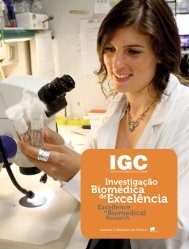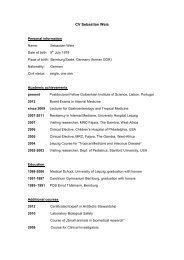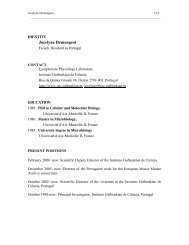organisation - the Instituto Gulbenkian de Ciência
organisation - the Instituto Gulbenkian de Ciência
organisation - the Instituto Gulbenkian de Ciência
- No tags were found...
You also want an ePaper? Increase the reach of your titles
YUMPU automatically turns print PDFs into web optimized ePapers that Google loves.
TRANSGENICS<br />
UNIT<br />
Moisés Mallo Head<br />
PhD in Molecular Biology, University of Santiago <strong>de</strong> Compostela, Spain, 1991<br />
PI of <strong>the</strong> Patterning and Morphogenesis Group<br />
Head of Facility since 2001<br />
The Transgenics Unit is <strong>the</strong> gene manipulation unit. The unit provi<strong>de</strong>s transgenic<br />
services to research staff. Both classic transgenics, by pronuclear microinjection,<br />
and gene targeting, by blastocyst injection of embryonic ES cells, are<br />
offered as a service. The unit also offers <strong>the</strong> cryopreservation of embryos for<br />
long-term storage.<br />
FACILITY STAFF<br />
Ana Nóvoa (Research Technician)<br />
MAJOR PROJECTS AND ACCOMPLISHMENTS<br />
The work of <strong>the</strong> unit during 2011 mostly involved <strong>the</strong> genesis of transgenic mice<br />
by pronuclear DNA injection. Most transgenics were produced by microinjection<br />
into <strong>the</strong> FVB/N background. This year, we produced transgenic lines from<br />
four different constructs. One of <strong>the</strong>m was a BAC reporter. The o<strong>the</strong>r three<br />
generated tools for conditional inactivation studies in meso<strong>de</strong>rmal <strong>de</strong>rivatives<br />
and for labelling embryonic muscle precursors with fluorescent proteins to allow<br />
<strong>the</strong>ir isolation from <strong>the</strong> living embryo using cell sorting approaches. The<br />
rest of <strong>the</strong> transgenic production was not aimed at generating transgenic lines<br />
because transgene expression resulted in embryonic lethal phenotypes. Therefore,<br />
<strong>the</strong>se injections were <strong>de</strong>signed for studies using a transient transgenic<br />
approach. During this year, we created transgenic embryos from more than 20<br />
different constructs, including two different BACs. Similar to previous years, <strong>the</strong><br />
transgenic efficiency was kept high, being around 30% for normal transgenics<br />
and 17% for transgenics injecting BAC constructs. The transgenic unit also produced<br />
four chimeric mice from one strain of ES-cells by injection into C57BL/6<br />
blastocysts. All <strong>the</strong>se animals contained higher than 70% chimerism.<br />
EQUIPMENT AND INFRASTRUCTURE<br />
• 1 Microinjection setup with Nikon inverted microscope equipped with DIC<br />
optics, and three dimensional Narishige micromanipulators;<br />
• 1 Microinjection setup with Leica inverted microscope equipped with DIC<br />
optics, and three dimensional, power assisted, Narishige micromanipulators;<br />
• 2 FemtoJet pump;<br />
• 1 Sutter P-87 Flaming/Brown micropipette puller;<br />
• 1 Zeiss SV6 Stereomicroscope with training head;<br />
• 2 Standard Zeiss SV6 Stereomicroscopes;<br />
• 1 CO2 incubator;<br />
• 1 Ultrasonic Cleaning Device.<br />
Funding Calouste <strong>Gulbenkian</strong> Foundation and Fundação para a Ciência e a<br />
Tecnologia, Portugal<br />
TwoCellEmbryos - Mouse embryos at <strong>the</strong> two-cell stage.<br />
IGC ANNUAL REPORT ‘11<br />
FACILITIES AND SERVICES<br />
87






